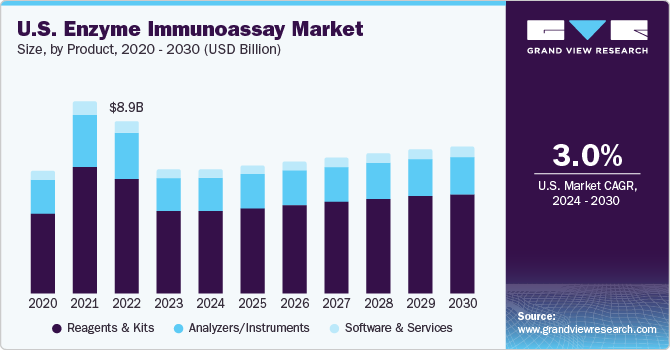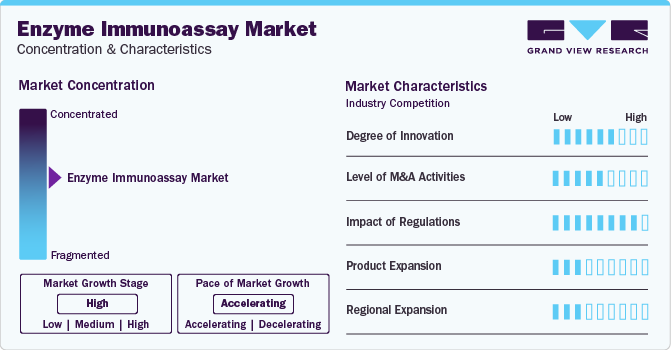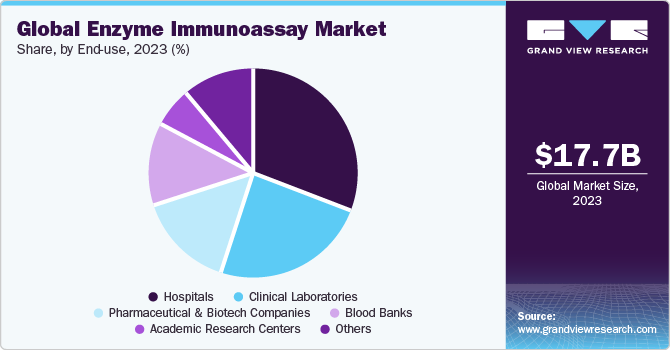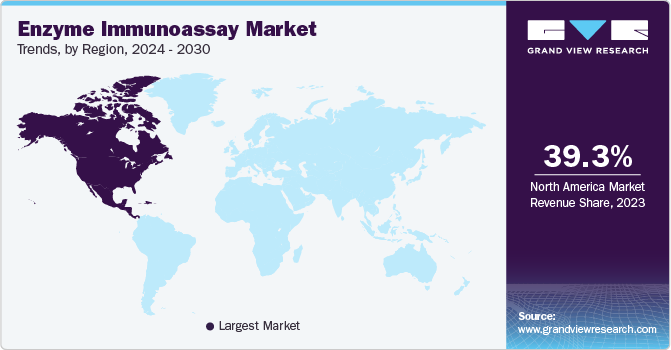
Enzyme Immunoassay Market Size, Share & Trends Analysis Report By Product (Reagents & Kits, Software & Services), By Application (Oncology, Cardiology), By Specimen, By End-use, By Region, And Segment Forecasts, 2024 - 2030
- Report ID: GVR-4-68040-290-4
- Number of Report Pages: 120
- Format: PDF, Horizon Databook
- Historical Range: 2018 - 2023
- Forecast Period: 2024 - 2030
- Industry: Healthcare
Enzyme Immunoassay Market Size & Trends
The global enzyme immunoassay market size was estimated at USD 17.67 billion in 2023 and is projected to witness a CAGR of 3.9% from 2024 to 2030. The growth of the market can be attributed to the increasing demand for automation in diagnostic tests, increasing prevalence of chronic and infectious diseases, and growing awareness and use of diagnostic services. Moreover, the growing geriatric population and increasing healthcare expenditure are also expected to drive market growth in the coming years.According to the WHO, by the year 2050, the global population aged 60 years and above is projected to double, reaching 2.1 billion individuals. Additionally, the number of people aged 80 years or older is expected to triple from 2020 to 2050, reaching a total of 426 million.

Enzyme Immunoassay (EIA) tests are extensively used to diagnose various infectious diseases, such as HIV, hepatitis B and C, tuberculosis, and certain types of influenza. According to the WHO, in 2022, 630 000 people died from HIV-related causes globally, and 39.0 million people were living with HIV. Governments and health organizations across the world implement public health campaigns to encourage regular HIV testing as a key strategy in HIV prevention and control. Such initiatives increase the utilization of EIA tests and drive the market.
Technological advancements are significant drivers for the enzyme immunoassay industry in the field of diagnostics for infectious diseases such as HIV, hepatitis B and C, tuberculosis, and certain types of influenza. Innovations in EIA technologies have led to improvements in test sensitivity, specificity, and speed, enhancing their utility in clinical settings. For instance, the development of automated EIA systems has significantly reduced manual labor and error rates while also increasing throughput capabilities. This automation allows for large-scale screening processes, which is especially beneficial in public health campaigns and areas with high disease prevalence.
Automation technologies, such as robotic liquid handling systems and integrated assay platforms, streamline the EIA workflow, reduce hands-on time, and increase sample throughput. High-throughput EIAs enable laboratories to process a large number of samples efficiently and meet the growing demand for diagnostic testing. For instance , in May 2023, Tosoh Europe N.V. launched AIA-CL300, a compact automated chemiluminescent enzyme immunoassay analyzer. Due to its compact size, this analyzer is a desktop device that can run in small and large laboratories.
Market Concentration & Characteristics
The high degree of innovation in the enzyme immunoassay market, driven by advances in scientific research, technology, and regulatory frameworks, has enhanced the capabilities of enzyme immunoassays. These innovations have made enzyme immunoassays more sensitive, specific, efficient, and user-friendly, contributing significantly to their application in clinical diagnostics and other fields.

Collaborations and partnerships play a crucial role in the EIA market by driving innovation, expanding market reach, and enhancing product development. Collaborations between academic institutions, research laboratories, and EIA manufacturers can lead to innovative solutions and advancements in immunoassay technologies. Partnerships provide the necessary resources, funding, and expertise to conduct extensive R&D activities. This collaborative effort accelerates the development of new and improved EIA kits and platforms, ensuring better sensitivity, specificity, and faster results.
The impact of regulations on the EIA market can be significant, influencing various aspects from development to market entry, and ongoing compliance. Enzyme immunoassays are widely used in clinical diagnostics and research for the detection and quantification of specific antigens or antibodies. As such, they are subject to a complex regulatory landscape that aims to ensure their safety, efficacy, and reliability. Regulations govern the approval process for new EIA products. In the U.S., the Food and Drug Administration (FDA) requires premarket approval or clearance for most diagnostic tests, including EIAs, under its medical device regulations. This process can be time-consuming and costly, affecting the time it takes for products to reach the market.
The EIA market is experiencing significant growth, driven by the increasing prevalence of chronic diseases, advancements in biotechnology, and the rising demand for more sensitive and specific diagnostic tests. As healthcare systems globally continue to emphasize early and accurate disease detection, EIA technologies are becoming integral components of diagnostic laboratories. One significant trend is the move towards fully automated EIA platforms. There's a growing demand for multiplex assays capable of detecting multiple analytes simultaneously from a single sample. Developing multiplex EIA products that maintain high specificity and sensitivity offers a competitive edge in the market.
Regional expansion in the EIA market is a strategic approach to scale operations, penetrate new markets, and leverage opportunities created by regional differences in healthcare needs, regulatory environments, and technological advancements. Developing countries offer significant growth opportunities for EIA products due to increasing healthcare expenditures, growing awareness about infectious diseases, and improving healthcare infrastructure. Companies can focus on solutions for specific regional health concerns, such as tropical diseases in Africa or dengue in Southeast Asia.
Product Insights
The reagents and kits segment dominated the market with the largest revenue share of 67.5% in 2023. Reagents and kits designed for enzyme immunoassays have found applications across a wide range of fields, including clinical diagnostics, pharmaceutical analysis, and food safety testing. This broad applicability has driven their dominance as they cater to a diverse set of needs and requirements. The reagents and kits used in EIAs are engineered to offer high sensitivity and specificity. This is crucial in detecting and quantifying substances at very low concentrations, making them essential in diagnostics, specifically in identifying markers for various diseases such as HIV, hepatitis, and cancer.
Furthermore, key players in the market are launching new reagnets and kits to capture major market share and it is expected to support market growth in forecast years. For instance, in February 2021, Agilent Technologies Inc. launched Agilent Dako SARS-CoV-2 IgG enzyme-linked immunosorbent assay kit. It detects IgG antibodies to SARS-CoV-2 in human blood serum or plasma.
The software and services segment is anticipated to register a significant CAGR from 2024 to 2030. The increasing complexity of immunoassay tests and the need for accurate, reliable results are pushing laboratories and healthcare facilities toward sophisticated software solutions. These solutions help in data management and ensure the precision of the assay results through advanced algorithms and data analysis techniques. In addition, the growing demand for automation in laboratories to handle high volumes of tests efficiently is another factor contributing to the growth of the software and services segment. Automation requires robust software to integrate different laboratory instruments and manage workflows, thereby driving the demand for specialized software solutions in the market.
Application Insights
Based on application, the infectious diseases testing segment dominated the market with the largest revenue share in 2023 and is anticipated to grow at the fastest CAGR over the forecast period. The high prevalence and incidence rates of infectious diseases worldwide, mainly in developing countries, drive the demand for effective and efficient diagnostic methods. Due to their sensitivity and specificity, EIAs have a high preference. In addition, public health initiatives and global health programs focusing on controlling infectious diseases such as HIV, TB, and malaria rely on serological assays, including EIAs, for screening and monitoring the disease burden. EIAs' ability to handle large volumes of samples efficiently and ideal for mass screening purposes, thereby contributing to their dominance in this application segment.
The oncology segment is anticipated to experience significant growth over the forecast period. This is primarily due to the increasing prevalence of cancer worldwide and the need for early detection and monitoring of this disease. According to the American Cancer Society, approximately 1.96 million new cases of cancer diagnosed in 2023. Due to their high sensitivity and specificity, enzyme immunoassays are a preferred method for the detection of biomarkers associated with various types of cancer. These assays can detect the presence of certain enzymes produced by cancer cells, aiding in the early diagnosis and treatment of the disease. Furthermore, advancements in technology have led to the development of more efficient and cost-effective EIA tests, making them accessible to a broader range of healthcare facilities, including those in emerging markets.
Specimen Insights
Based on specimen, the blood specimen segment dominated the market with the largest revenue share in 2023. Blood tests are a standard and crucial diagnostic tool across various medical specialties. Given that blood circulates throughout the body, it can carry markers of disease from different organs, making it an ideal specimen for broad-spectrum disease screening and monitoring, including infections, chronic diseases, and hormonal imbalances. Blood-based enzyme immunoassays are highly sensitive and specific. They can detect low levels of antigens and antibodies with a high degree of accuracy. This makes them important in early disease detection and in cases where accurate diagnosis is critical, such as in HIV or hepatitis testing.
The urine specimen segment is anticipated to grow at the fastest CAGR over the forecast period. Urine sampling is a non-invasive method, which makes it more favorable for patients and healthcare providers. This ease of collection encourages its preference, especially for regular monitoring and screening purposes. There is an increasing demand for point-of-care (POC) testing that can be performed outside traditional laboratory settings. Urine-based EIA kits are well-suited for POC testing because they can provide rapid results with minimal equipment. With a growing focus on preventive healthcare and early disease detection, screening programs for various conditions are increasing. Simple and effective urine tests are used in these programs, contributing to the segment's growth.
End-use Insights
The hospital segment dominated the market with the largest revenue share in 2023. Hospitals are primary healthcare institutions where a wide range of diseases are diagnosed and treated. They handle a high volume of patient samples for various tests, including those for infectious diseases, autoimmune disorders, and hormonal imbalances, making extensive use of EIA technologies. Hospitals require diagnostic methods that are both rapid and accurate to manage patient care effectively. EIAs fulfill these needs by providing timely and precise results, which are critical for making informed treatment decisions. Hospitals in developed countries have the financial resources and infrastructure to adopt the latest diagnostic technologies, including advanced EIA platforms. The need for better diagnostic accuracy, patient outcomes, and operational efficiency drives this adoption.

The clinical laboratories segment is anticipated to grow at the fastest CAGR over the forecast period. There is a growing demand for diagnostic services due to the rising prevalence of chronic diseases and infectious diseases and the need for early disease detection. Clinical laboratories play a crucial role in the diagnosis and management of these conditions through various tests, including enzyme immunoassays. There is a rising awareness among the general population about the importance of preventive healthcare and early diagnosis. Coupled with increasing healthcare expenditure by governments and individuals, this trend supports the growth of diagnostic services, including those offered by clinical laboratories.
Regional Insights
North America accounted for the largest market share of 39.30% in 2023 for the enzyme immunoassay market. North America, mainly the U.S., is known for its advanced healthcare infrastructure and robust biotechnology research sectors. Continuous investments and developments in these areas have led to innovations in EIA technologies, making them more efficient and reliable. Government initiatives in North America aimed at improving healthcare quality and accessibility, along with funding for research and development in the field of diagnostics, have significantly contributed to the growth of the EIA market.

U.S. Enzyme Immunoassay Market Trends
The enzyme immunoassay market in the U.S. is expected to grow over the forecast period due to the presence of a large number of market players in the U.S., undergoing various strategic initiatives such as collaborations and new product launches. Furthermore, the increasing prevalence of cardiovascular diseases in the U.S. is one of the major drivers for the U.S. EIA market. EIAs detect cardiac markers, which are crucial for diagnosing heart attacks and other cardiovascular conditions. According to the 2024 Statistics Update by the American Health Association, Cardiovascular disease, listed as the underlying cause of death, accounted for 931,578 deaths in the U.S. in 2021.
Europe Enzyme Immunoassay Market Trends
The enzyme immunoassay market in Europe has seen a rise in the number of chronic diseases such as diabetes, cancer, cardiovascular diseases, and infectious diseases. This increase boosts the demand for effective diagnostic methods, including enzyme immunoassays, for early detection and monitoring of these conditions. Europe has some of the world's leading biotechnology firms and research institutions, which contribute to the development of innovative EIA technologies and products. Moreover, the well-established healthcare infrastructure and a strong focus on research and development in European countries support the adoption of advanced diagnostic methods, which is expected to support market growth.
The UK enzyme immunoassay market held a significant share in 2023. The UK government's investment in research and development is one of the major factors driving the growth of the enzyme immunoassay market in the country. With increasing focus on developing innovative technologies and products, the demand for high-quality enzyme immunoassay has been on the rise. The government's support in the form of funding for research and development activities, tax incentives, and favorable policies has encouraged companies to invest in this sector. For instance, in November 2023, The UK government announced investments of USD 652.9 million for life sciences funding, changes to R&D tax credits, and a clinical trials accelerator scheme. This growing investment are anticipated to boost the demand for enzyme immunoassay over the forecast period.
The enzyme immunoassay market in France is expected to grow remarkably over the forecast period. The French government provides support for life sciences research and innovation through funding programs, tax incentives, and infrastructure development. This support encourages investment in healthcare, biotechnology, genomics, and personalized medicine, driving the demand for enzyme immunoassays in these sectors.
Germany enzyme immunoassay market is anticipated to grow significantly over the forecast period. Germany is one of the global leaders in scientific research, with renowned institutions and multiple biotechnology companies actively developing enzyme immunoassay, research tools, and novel therapeutics. This advancement is predicted to support enzyme immunoassays market growth by creating demand for high-quality enzyme immunoassay services.
Asia Pacific Enzyme Immunoassay Market Trends
The Enzyme immunoassay market in Asia Pacific is expected to show the highest CAGR of 6.5% over the forecast period. Countries in the Asia Pacific region, such as China, India, Japan, South Korea, and Singapore, are experiencing rapid industrialization and economic growth. This growth fuels demand across various industries, including pharmaceuticals and biotechnologies, all of which require enzyme immunoassays. Governments and private companies in the Asia Pacific are investing significantly in healthcare infrastructure, pharmaceutical research, and life sciences. This investment boosts the demand for enzyme immunoassays, which are essential in infectious diseases. The Asia Pacific region is home to a large and rapidly growing population, coupled with increasing urbanization. This demographic trend drives the demand for healthcare services, leading to increased pharmaceutical production and research activities and boosting the enzyme immunoassay market.
China enzyme immunoassay market is expected to grow significantly over the forecast period as the Chinese government is actively promoting the development of the domestic pharmaceutical industry, including enzyme immunoassay products. These government initiatives translate into funding for research and development, which can benefit the enzyme immunoassay market. Furthermore, China's aging population is a factor as it creates a greater demand for treatments for chronic and infectious diseases, a category where enzyme immunoassay are used. This increased need for treatments is expected to fuel the enzyme immunoassay market.
The enzyme immunoassay market of Japan is expected to grow significantly over the forecast period. Japan investing significantly in biotechnology research and development. Advancements in biotechnology drive the demand for enzyme immunoassays. For instance, in 2019, the government of Japan funded approximately USD 56 million to promote bio-manufacturing technologies, including the examination and demonstration of bio-manufacturing data linkages.
MEA Enzyme Immunoassay Market Trends
The Enzyme immunoassay market in MEAis expected to grow exponentially over the forecast period. MEA region is witnessing an increase in investments in the healthcare sector, mainly in the development of healthcare infrastructure and capabilities. This trend is expected to fuel the demand for enzyme immunoassays in the region. However, the MEA region is a relatively small market for enzyme immunoassays compared to other regions, and the market growth is limited by factors such as stringent regulatory standards and quality requirements for pharmaceutical and biotechnology products.
Saudi Arabia enzyme immunoassay market is expected to grow over the forecast period. Saudi Arabia has been investing significantly in developing its biotechnology and healthcare sectors. With a growing focus on research and innovation in life sciences, there is increasing demand for enzyme immunoassays, which are essential in treatment for chronic and autoimmune diseases.
The enzyme immunoassay market in Kuwait is anticipated to grow over the forecast period. Kuwait has been investing significantly in its healthcare infrastructure, including hospitals and laboratories, which increases the capacity for various diagnostic tests, including EIAs. Kuwait faces challenges with chronic diseases such as diabetes, cardiovascular diseases, and various types of cancer. The need for early diagnosis and management of these conditions drives the demand for EIA tests. TheKuwaiti government allocates a significant portion of its budget to healthcare, aiming to provide comprehensive services to its citizens. Increased healthcare spending supports the adoption of advanced diagnostic technologies, including EIA.
Key Enzyme Immunoassay Company Insights
Key players operating in the enzyme immunoassay industry are adopting product approval to increase the reach of their products in the market and improve the availability of their products in diverse geographical areas, along with expansion as a strategy to enhance production/research activities. In addition, several market players are acquiring smaller players to strengthen their market position. This strategy enables companies to increase their capabilities, expand their product portfolios, and improve their competencies.
Key Enzyme Immunoassay Companies:
The following are the leading companies in the enzyme immunoassay market. These companies collectively hold the largest market share and dictate industry trends.
- Siemens Healthineers
- Danaher Corporation (Beckman Coulter)
- bioMérieux SA
- QuidelOrtho Corporation.
- Sysmex Corporation
- Bio-Rad Laboratories, Inc.
- F. Hoffmann-La Roche AG
- Becton, Dickinson, and Company
- Thermo Fisher Scientific, Inc.
Recent Developments
-
In December 2023, H.U. Group Holdings Inc. launched the Lumipulse G pTau 217, a Plasma assay designed for the fully automated LUMIPULSE G immunoassay platforms. This advanced chemiluminescent enzyme-immunoassay accurately quantifies the levels of Tau protein phosphorylated at threonine 217 in human K2EDTA plasma samples. This process is completed in just 35 minutes.
-
In February 2023, Charles River, a company specializing in life sciences, launched an Enzyme-Linked Immunosorbent Assay (ELISA) kit. This ELISA kit utilizes IgY antibodies to detect and quantify residual host cell protein in biotherapeutics created with Chinese hamster ovary.
-
In June 2022, BIOTEM, a company offering development and production services for custom monoclonal antibodies and immunoassays, is building a new industrial facility. The new site is located in France. This new facility is dedicated to immunoassay production, allowing BIOTEM to increase its capacity and meet the growing demand for these tests.
Enzyme Immunoassay Market Report Scope
|
Report Attribute |
Details |
|
Market size value in 2024 |
USD 17.78 billion |
|
Revenue forecast in 2030 |
USD 22.42 billion |
|
Growth rate |
CAGR of 3.9% from 2024 to 2030 |
|
Actual data |
2018 - 2023 |
|
Forecast period |
2024 - 2030 |
|
Quantitative units |
Revenue in USD million/billion and CAGR from 2024 to 2030 |
|
Report coverage |
Revenue forecast, company ranking, competitive landscape, growth factors, and trends |
|
Segments covered |
Product, application,specimen, end-use, region |
|
Regional scope |
North America; Europe; Asia Pacific; Latin America; MEA |
|
Country scope |
U.S.; Canada; UK; Germany; France; Italy; Spain; Denmark; Sweden; Norway; Japan; China; India; Australia; Thailand;South Korea; Brazil; Mexico, Argentina; South Africa; Saudi Arabia, UAE; Kuwait |
|
Key companies profiled |
Siemens Healthineers; Danaher Corporation (Beckman Coulter); bioMérieux SA; QuidelOrtho Corporation.; Sysmex Corporation; Bio-Rad Laboratories, Inc.; F. Hoffmann-La Roche AG; Becton, Dickinson, and Company; Thermo Fisher Scientific, Inc. |
|
Customization scope |
Free report customization (equivalent up to 8 analyst's working days) with purchase. Addition or alteration to country, regional & segment scope. |
Global Enzyme Immunoassay Market Report Segmentation
This report forecasts revenue growth at the global, regional, and country levels, and provides an analysis of the latest industry trends in each of the sub-segments from 2018 to 2030. For this report, Grand View Research has segmented the global enzyme immunoassay market report based on product, application,specimen, end-use, and region.
-
Product Outlook (Revenue, USD Million, 2018 - 2030)
-
Reagents & Kits
-
Analyzers/Instruments
-
Software & Services
-
-
Application Outlook (Revenue, USD Million, 2018 - 2030)
-
Therapeutic Drug Monitoring
-
Oncology
-
Cardiology
-
Endocrinology
-
Infectious Disease Testing
-
Autoimmune Diseases
-
Others
-
-
Specimen Outlook (Revenue, USD Million, 2018 - 2030)
-
Blood
-
Saliva
-
Urine
-
Other Specimens
-
-
End-use Outlook (Revenue, USD Million, 2018 - 2030)
-
Hospitals
-
Blood Banks
-
Clinical Laboratories
-
Pharmaceutical and Biotech Companies
-
Academic Research Centers
-
Others
-
-
Regional Outlook (Revenue, USD Million, 2018 - 2030)
-
North America
-
U.S.
-
Canada
-
-
Europe
-
UK
-
Germany
-
France
-
Italy
-
Spain
-
Denmark
-
Sweden
-
Norway
-
-
Asia Pacific
-
Japan
-
China
-
India
-
Australia
-
Thailand
-
South Korea
-
-
Latin America
-
Brazil
-
Mexico
-
Argentina
-
-
Middle East and Africa (MEA)
-
South Africa
-
Saudi Arabia
-
UAE
-
Kuwait
-
-
Frequently Asked Questions About This Report
b. The global enzyme immunoassay market size was estimated at USD 17.67 billion in 2023 and is expected to reach USD 17.78 billion in 2024.
b. The global enzyme immunoassay market is expected to grow at a compound annual growth rate of 3.9% from 2024 to 2030 to reach USD 22.42 billion by 2030.
b. North America dominated the enzyme immunoassay market with a share of 39.3% in 2023. This is attributable to the large number of end users, such as hospitals, blood banks, and clinical laboratories in the region
b. Some key players operating in the enzyme immunoassay market include Siemens Healthineers; Danaher Corporation (Beckman Coulter); bioMérieux SA; QuidelOrtho Corporation.; Sysmex Corporation; Bio-Rad Laboratories, Inc.; F. Hoffmann-La Roche AG; Becton, Dickinson, and Company; Thermo Fisher Scientific, Inc.
b. Key factors that are driving the market growth include rising incidence of chronic and infectious diseases along with growing demand for point-of-care diagnostics
We are committed towards customer satisfaction, and quality service.
"The quality of research they have done for us has been excellent."




